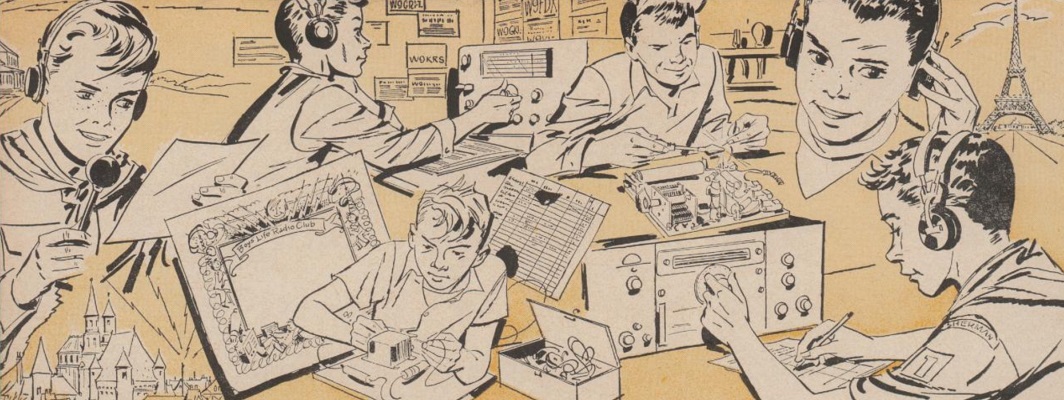I have been using small footprint computers in ham shack for a while. It started with the Dell Zino. Always a bit under powered, but enough to get the hamming done. The latest computer driving everything was one of those barebones models that was the size of a shoe box. The first sign of decline was when the fan kept getting louder and LOUDER. The the drive (500GBs of SATA) then decided to give up the ghost.
An immediate lesson learned… back up my log. I have been good at uploading my logs (almost daily, when on the air) to LOTW, QRZ.com, and eQSL. But I would only export that days contacts, consistently replacing the previous days exported log.
I choose not to abandon the small footprint computer and went back to the Shuttle. Newegg.org was my one stop shopping:
The case and motherboard: Shuttle XH81 Intel Core i7 / i5 / i3 / Pentium / Celeron 65W Intel H81 1 x HDMI Barebone system
– small form factor, fits neatly underneath monitor.
– 2x RS-232 connections on the back. Perfect for connecting to the Elecraft amp and tuner.
– Plenty of USB connections
Intel Core i7-4770S Haswell Quad-Core 3.1 GHz LGA 1150 65W BX80646I74770S Desktop Processor Intel HD Graphics
– not the fastest, but fast enough.
– comes with a super quiet fan.
Transcend JetRam 8GB 204-Pin DDR3 SO-DIMM DDR3 1600 (PC3 12800) Laptop Memory Model JM1600KSH-8G
– I got two DIMMs to keep things moving… 16GBs = snappy!
SAMSUNG 850 EVO 2.5″ 250GB SATA III 3-D Vertical Internal Solid State Drive (SSD) MZ-75E250B/AM
– Good bye disk, hello solid state. Faster. Silent.
The actual build was plug and play. The Shuttle line has come a long way since my last experience with their product. I think these specific computers are designed to operate older types of technology (hint…. 2x RS-232 connections?) which works great with most amateur radio needs.
The next step was loading the OS. LiLi USB Creator is my go to solution for installing linux when I don’t have an optical drive (which is more often the case). This allows you to load the OS through booting directly from the USB stick.
The linux flavor of the day: Mint with the MATE edition. I was an Ubuntu man until Unity. Then made the jump to Mint. The OS loaded without issue and I was off and running.
Amazingly enough, I was able to install TQSL-2.2. In the past, I have been able to install TQSL from the Software Manager. But this has been an older version of TQSL. The newer versions ALWAYS gave my problems with dependency issues during attempted installs. I stayed with it this time and finally got it working. Phew!
The install of fldigi went smoothe, but configuring it to work with my Elecraft K3 was giving me fits. In my past setup, I’ve always used hamlib for rig control and the trick was just finding which USB number was being used for my USB Microham III. But this time, the USB Microham III was identified by name as a choice. Great! But it didn’t initialize. I tried USB0 (…. nothing), combed over the results of lsusb…. not… working. After some intense Googling, I ran across a command I had never seen before:
sudo adduser [username] dialout
Dialout!? Who knew? But that did the trick.
Now, here is something funny. We all have our junk boxes. As hams, we are pack rats. We hang on to stuff that has no current use, but may someday. I had a box RS-232 cables. When Fall Cleaning swept through the ham shack, I looked at the RS-232 cables. I am really going to need 15 RS-232 cables ranging in length between two and 15 feet? The box headed to the dump.
Now, with my growing K-Line, I can use Elecraft software (linux versions available) to monitor data from the amp and tuner. But the connections are serial. SERIAL. I turned the ham shack upside down and not an RS-232 cable to be found. I really don’t want to have to actually go out and BUY a serial cable.






 It is snowing now – NWS says we’ll get 2 inches. I am hoping for more. I’ll have to do a bit of shoveling to clear the driveway in the morning, then I’ll head out with the 4 year old for some sledding. Should be a good time, although with
It is snowing now – NWS says we’ll get 2 inches. I am hoping for more. I’ll have to do a bit of shoveling to clear the driveway in the morning, then I’ll head out with the 4 year old for some sledding. Should be a good time, although with 

